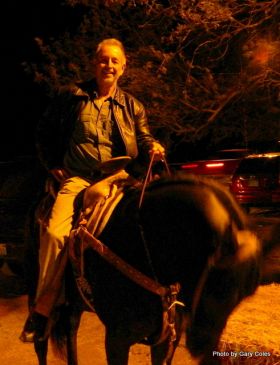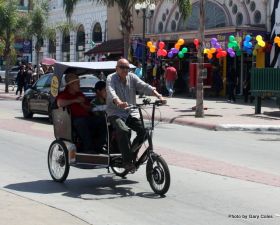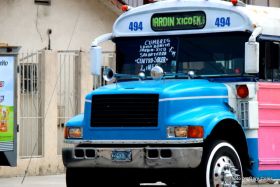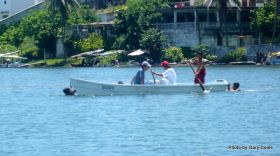What’s the best way to get around in Mexico?
Gary Coles - Paradise For Gringos
 There are many ways for you to travel in Mexico and I’ve tried most of them. My favorite is by foot. Whenever I have a chance I like to walk and explore the cities, the forests, the deserts, the mountains and the beaches. Mexico is a delight for all your senses and if you get away from modern transportation, you have a much better chance of enjoying the beauty and heritage of Mexico.
There are many ways for you to travel in Mexico and I’ve tried most of them. My favorite is by foot. Whenever I have a chance I like to walk and explore the cities, the forests, the deserts, the mountains and the beaches. Mexico is a delight for all your senses and if you get away from modern transportation, you have a much better chance of enjoying the beauty and heritage of Mexico.And since I am a cowboy at heart, I love to ride a horse. Although I have not...
 There are many ways for you to travel in Mexico and I’ve tried most of them. My favorite is by foot. Whenever I have a chance I like to walk and explore the cities, the forests, the deserts, the mountains and the beaches. Mexico is a delight for all your senses and if you get away from modern transportation, you have a much better chance of enjoying the beauty and heritage of Mexico.
There are many ways for you to travel in Mexico and I’ve tried most of them. My favorite is by foot. Whenever I have a chance I like to walk and explore the cities, the forests, the deserts, the mountains and the beaches. Mexico is a delight for all your senses and if you get away from modern transportation, you have a much better chance of enjoying the beauty and heritage of Mexico.And since I am a cowboy at heart, I love to ride a horse. Although I have not ridden one yet, I want to ride a burro someday – what a relaxed and unhurried way to view the countryside.
 Advancing to more modern transportation, you may ride in tricycle type taxis which may be powered by a small motor or by foot-power from the driver. They are usually only in cities or tourist areas. In Asia, the are called tuk-tuks or rickshaws but the only words used here seem to be tricycle or taxi.
Advancing to more modern transportation, you may ride in tricycle type taxis which may be powered by a small motor or by foot-power from the driver. They are usually only in cities or tourist areas. In Asia, the are called tuk-tuks or rickshaws but the only words used here seem to be tricycle or taxi.Regular taxis abound in Mexico. The streets are filled with them. There are different types and you should ask for local advice before using them. In some areas, it is considered unsafe unless you take an authorized taxi. You also need to know whether you will pay a metered price or if you need to negotiate a price in advance.
 One type of taxi is called a colectivo. It is basically a van or car that follows a specific route. Drivers watch and stop anywhere along the route to pick up or drop off passengers. They are much cheaper than a regular taxi, but drivers squeeze in as many people as possible. One evening, I counted 16 of us in the taxi and I think the driver would have stopped for more if anyone else would have been along the route.
One type of taxi is called a colectivo. It is basically a van or car that follows a specific route. Drivers watch and stop anywhere along the route to pick up or drop off passengers. They are much cheaper than a regular taxi, but drivers squeeze in as many people as possible. One evening, I counted 16 of us in the taxi and I think the driver would have stopped for more if anyone else would have been along the route.Regular cars are a great way to travel around the countryside but it seems most expatriates are uncomfortable in the big cities. The driving here can be crazy – I’ve noticed that t is rare for drivers to stop or even slow very much for stop signs. Traffic circles are really confusing to most drivers from the US. In fact, Tijuana has many drivers from the US and finally gave up on most of the major traffic circles and installed traffic lights. Toppes are another challenge - they are speed bumps and they mean business. Some are marked with warning signs but many are not. You are also likely to see livestock on many of the roads and you really need to watch out for pedestrians. Always remember --- you have to be much more careful driving in Mexico.
 The most common transportation for most people in Mexico is by bus. In cities, the buses will usually stop anywhere if a passenger is waiting. They seldom have marked bus stops. There are lots of buses and you seldom have to wait and the prices are really cheap. Bus traffic between the cities is also reasonably priced and they have three classes of service. The first class buses are excellent and a comfortable way to travel. They may even offer complimentary snacks and drinks along with a movie. They only stop at major points. Second class buses may not be air-conditioned and stop at a lot more places. The third class buses will usually stop for anyone along the road. They can get crowded and it would be rare to find air-conditioning.
The most common transportation for most people in Mexico is by bus. In cities, the buses will usually stop anywhere if a passenger is waiting. They seldom have marked bus stops. There are lots of buses and you seldom have to wait and the prices are really cheap. Bus traffic between the cities is also reasonably priced and they have three classes of service. The first class buses are excellent and a comfortable way to travel. They may even offer complimentary snacks and drinks along with a movie. They only stop at major points. Second class buses may not be air-conditioned and stop at a lot more places. The third class buses will usually stop for anyone along the road. They can get crowded and it would be rare to find air-conditioning.A number of cities now have BRT (bus rapid transit systems). These have actual stations and the intent is to reduce congestion.
Mexico City and Monterrey have Metro systems (subways). I’ve always enjoyed the stations in Mexico City with lots of small shops and often local musicians or other artists will be found. Some of the simple musical performances will draw a nice crowd.
There is almost no train service in Mexico. There is a tourist train (El Chepe) that takes you through the Copper Canyon. Another train (Tequila Express) goes to the tequila region from Guadalajara. And a third train travels from Tijuana to Tecate.
 You may have a chance to travel by boat or ferry. Small boats can be found on rivers and lakes. There are ferry routes to some of the islands and from Baja California to the mainland. Mexico also has a number of ports that you can visit from cruise lines.
You may have a chance to travel by boat or ferry. Small boats can be found on rivers and lakes. There are ferry routes to some of the islands and from Baja California to the mainland. Mexico also has a number of ports that you can visit from cruise lines.Of course, the fastest way to travel is by air. The ticket prices are very reasonable. I once flew from Las Vegas to San Diego and then took a local airline from Tijuana to Mexico City and my total cost including one night in a hotel was less than the ticket price of a major US Airline direct from Las Vegas to Mexico City.
Mexico has over 1,800 airports (3rd in the world). About 100 of them are international or major type airports and that gives excellent coverage for most of the country. The airport in Mexico City is the largest in Latin America. It and six others are responsible for 90% of the air traffic in Mexico. The other six are in Guadalajara, Cancún, Monterrey, Tijuana, Acapulco and Puerto Vallarta.
There are many ways to get around Mexico and the best is up to you.
Posted December 6, 2016



.png)